(单词翻译:单击)
5.Argentavis Magnificens
5.阿根廷巨鹰
Argentavis magnificens translates to "magnificent Argentine bird." Its skeleton was discovered in Miocene rocks in Argentina, indicating this species of giant teratorn lived in South America six million years ago. It's the largest flying bird on record. This creature could grow to more than 1.8 meters (6 ft) tall, with an impressive wingspan of 6–8 meters (19–26 ft). The heaviest among them weighed more than 68 kilograms (150 lb). Compare this to the wandering albatross, which has the largest wingspan of any modern bird at 3.5 meters (11.5 ft).
阿根廷巨鹰的骨架在中新纪的岩石上被发现,而这块岩石在阿根廷被发现。这就意味着这个种类的巨鹰曾在6百万年前生活在南美洲。阿根廷巨鹰是世上已知的最大的飞行鸟类。它们能长到超过1.8米,惊人的是,它们的翼展能达到6到8米。其中最重的巨鹰体重能超过68公斤。即使漂泊信天翁也不能与之相比。而漂泊信天翁的翼展是现代鸟类中翼展最大的,达到了3.5米。
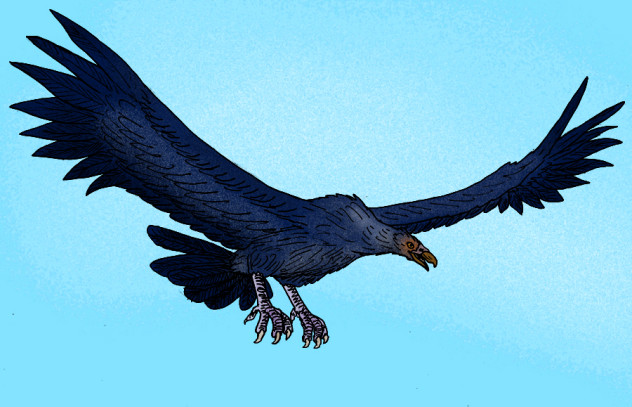
Argentavis magnificens was a member of the Accipitirformes order. Other members include hawks and vultures. Much like these birds, the giant teratorn's chest muscles would not support excessive flapping; it seems the bird mostly soared through the air, either hunting or searching for carrion. The giant teratorn's skull structure suggests it swallowed prey whole. Lifespan is estimated to have been between 50–100 years.
阿根廷巨鹰是鹰隼目。另外老鹰和秃鹰也属于鹰隼目。就像这些鹰隼目的成员一样,阿根廷巨鹰的胸部肌肉并不能支持它们过多的拍打。阿根廷巨鹰飞到空中的原因不外乎是捕食或寻找腐肉。阿根廷巨鹰头骨的结构表明它们是将猎物整个吞下的。阿根廷巨鹰的寿命可以达到50至100年。
4.Barbary Lion
4.巴巴里狮
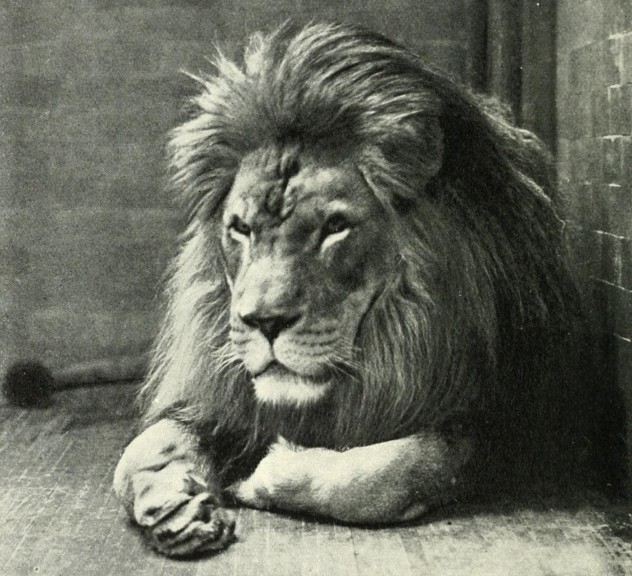
The regal Barbary lion used to roam North Africa freely. This species was unique as it traveled, not in prides, but in pairs or small family groups. Also known as an Atlas lion, the Barbary lion was a highly recognizable and stunning creature with a distinctive head shape and mane. A male's extra-long fur surrounded the face, and grew from the chest and stomach as well.
高贵的巴巴里狮曾经自由游荡在北非大陆上。巴巴里狮独特在它们总是成双或者以小家庭方式活动,而非独自游荡。巴巴里狮的辨识度很高,因它们有着独特的头型和鬃毛。从胸腹部开始,雄狮长着长毛,并一直长到脸部。雄性巴巴里狮的脸部围着一圈鬃毛。
The last wild Barbary lion was shot in Morocco in 1927. Since the sultan of Morocco owned domesticated Barbary lions, a small number of ancestors survive in captivity. These royal pets were transferred to Moroccan and European zoos for show and breeding. This isn't the only time they've been kept out of the wild, though. Barbary lions were used in combat against gladiators during the Roman Empire. What's worse than a regular old fight to the death? Being shredded to pieces by a lion might be worse.
最后一只野生的巴巴里狮于1927年在摩洛哥被枪杀。由于摩洛哥的统治者驯养了巴巴里狮,少数一些驯化的巴巴里狮在囚禁中活了下来。这些皇家的宠物被运送到摩洛哥和欧洲的动物园,以供观赏和繁殖后代。这并非巴巴里狮首次被圈养并远离野外。在罗马帝国时期,巴巴里狮曾被用于与角斗士搏斗。与常规的死斗相比,还有什么比这更糟糕呢?哦,被狮子撕成碎片或许更糟糕。
3.Laughing Owl
3.笑鸮
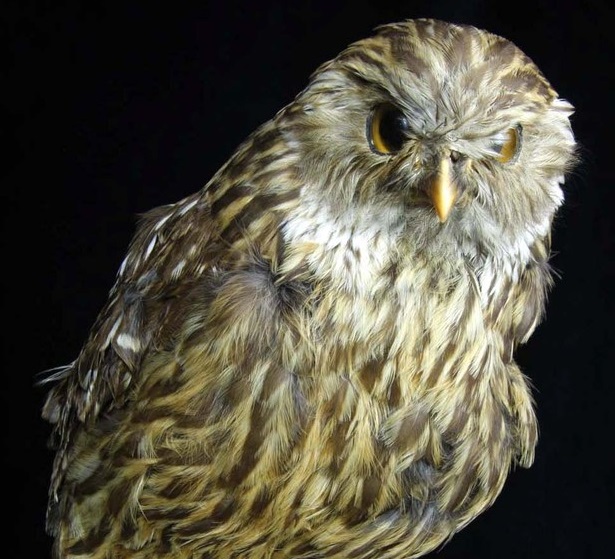
The Sceloglaux albifacies laughing owl was native to New Zealand. It became rare in the mid-1800s. The island's only endemic owl, it was last spotted in 1914. Unconfirmed reports suggest it might have survived up until the 1930s. The laughing owl's hoot sounds like a creepy cackle or madman's snicker. Its vocalizations have also been compared to a dog's bark. Other species of laughing owl survive today and it's possible to hear the sound online.
笑鸮是纽西兰特有的一种猫头鹰。在1800年代中期开始,笑鸮渐渐消失。人们最后一次见到笑鸮是在1914年。未经证实的报道说笑鸮可能一直存活到1930年代。笑鸮的叫声听起来就像令人惊悚不已的咯咯声或是疯子的窃笑。人们曾将它们的叫声与狗叫相较。仍有其他种类的笑鸮存活至今,至今,人们也能在网上搜索听到笑鸮的叫声。
Laughing owls nested on rocks around forest borders and in open country. Some were taken into captivity. They thrived as pets, and even laid eggs without encouragement. In the wild, human settlement and habitat destruction caused them to change their diet. They switched from eating sizable birds (such as ducks) and lizards to more mammals. After this dietary adjustment, natural predators likely hunted them to extinction. Grazing and agricultural burning could have also influenced their quick eradication.
笑鸮一般在森林边缘或空旷野外的岩石上筑巢。一些笑鸮也被人捕捉圈养,并在人类的饲养下大肆繁衍。野生的笑鸮则因人类定居以及栖息地的破坏而改变了自身饮食习惯。它们不再捕食与自身体型相当的鸟类(例如鸭子)和蜥蜴,转而开始捕食哺乳动物。在它们的捕食习惯改变之后,它们的天敌竟将它们捕杀殆尽。放牧和农业燃烧也可能是笑鸮快速灭绝的原因。
2.Bluebuck
2.蓝马羚
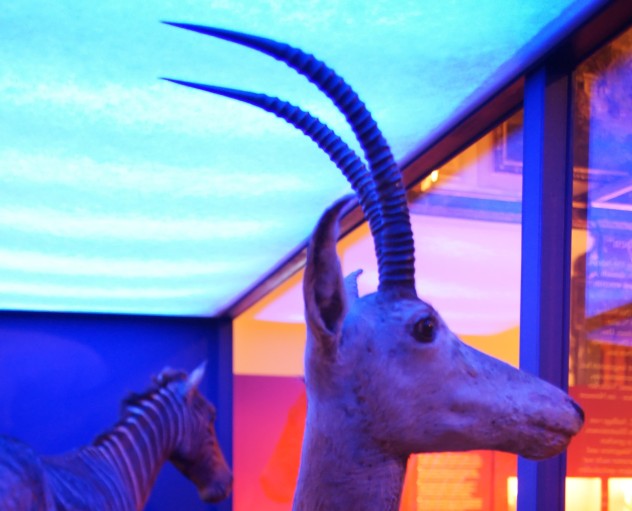
The extinct bluebuck may otherwise be called a blaubok or blue antelope. This animal's black and yellow coloring gave its fur a blue appearance, though the species never actually grew blue fur. It was native to southern Africa. Grassy open areas were ideal for grazing, and bluebucks also enjoyed chomping on bark. They were social creatures, and most likely nomadic. African lions, hyenas, and leopards hunted them before humans arrived.
灭绝的蓝马羚毛色黑黄,一眼看去,就向蓝色的一样。然而尽管叫做"蓝马羚",它们的毛色却非为真正蓝色。蓝马羚是南非特有的动物。南非广阔的草原使其成为天然放牧场,而蓝马羚则天生喜爱啃咬树皮。蓝马羚是群聚动物,并有可能还是迁徙性动物。在人类的足迹到达南非草原之前,非洲狮、鬣狗和豹是蓝马羚的最大捕食者。
The population began to decline noticeably around 2,000 years ago. This is when competing livestock were introduced into their habitat. Bluebucks had become rather rare by the 18th century. Predators, climate change, hunting, disease, and even the presence of animals, such as sheep, in their territory may have contributed to their extinction. The last known bluebuck was shot in 1799. Five mounted heads are displayed at different museums in Europe—one each in Austria, France, and Amsterdam, and two in Sweden.
蓝马羚数量从大约2千年前开始明显下降。而这时与蓝马羚相争的其他动物正好被引入到它们的栖息地。到了18世纪,蓝马羚已经变得相当稀少。捕食者的捕杀、气候变化、人类猎杀、疾病,甚至是另外一些出现在它们领土上的动物,例如绵羊,都或多或少地造成了蓝马羚的灭绝。最后一只蓝马羚在1799年被射杀。当今仅存5个蓝马羚头颅,它们被装裱好,分别收藏于奥地利、法国、荷兰和瑞典的博物馆。其中瑞典拥有两个蓝马羚的头颅。
1.Woolly Rhinoceros
1.长毛犀牛
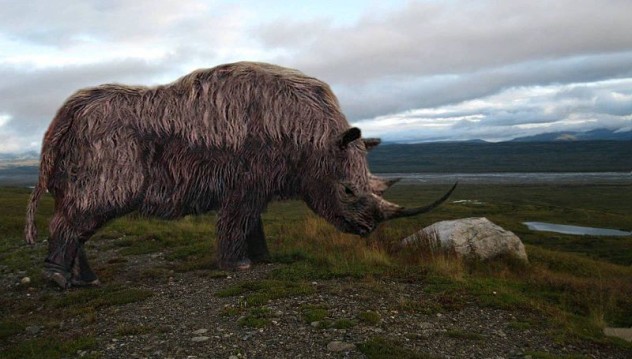
If you've ever wondered what a shaggy rhino might look like, the woolly rhinoceros is it. Fossils up to 3.6 million years old have been recovered from Asia, Europe, and North Africa—the oldest from Tibet. One woolly rhino's gigantic horns were originally mistaken for prehistoric bird claws. Wear indicates woolly rhinos brushed their horns back and forth on the ground, as modern rhinos do ritualistically. The brushing could have pushed snow and other natural obstacles out of the rhino's way.
如果你曾幻想过若是犀牛变得毛发蓬松会怎样,那长毛犀牛将满足你对此的想象。有着360万年历史的化石在亚洲、欧洲和北非等地被发现,最老的那块化石则发掘自西藏。某次发现的长毛犀牛的一个巨大的牛角曾被误认为是史前鸟类的爪子。牛角上的磨损表明长毛犀牛可能经常在地面上来回摩擦自己的牛角,这正像现代犀牛经常所为。长毛犀牛以其角摩擦地面开路,将阻挡脚步的雪以及其他天然障碍物推开。
Woolly rhinos shared territory with woolly mammoths. Though both were especially populous in Russia, neither crossed the Bering Strait land bridge into North America. Woolly rhinos lasted through many centuries. Caves in France show 30,000-year-old depictions of woolly rhinoceri. They were hunted by primitive humans, and became a common subject of cave art. A 13,300-year-old spear was found in Siberia in 2014, crafted from the horn of a mature woolly rhino. It's believed this creature went extinct at the end of the most recent ice age approximately 11,000 years ago.
长毛犀牛与猛犸共享领地。两者大都集中在俄罗斯地区,却并未曾通过白令海峡大陆桥进入到北美州。长毛犀牛在地球上存活了几个世纪之久。法国一个洞穴中发现了具有3千年历史之久的长毛犀牛的画像。长毛犀牛是原始人的捕猎对象,因而它们也成为了当时洞穴的常用装饰。2014年,一支有着13,300年历史的矛在西伯利亚被人发现。这矛正是用成年长毛犀牛的牛角所制。学界认为,长毛犀牛是在最近一次的冰河时代,也就是大约11,000年前灭绝的。
翻译:敖-有没 来源:前十网


